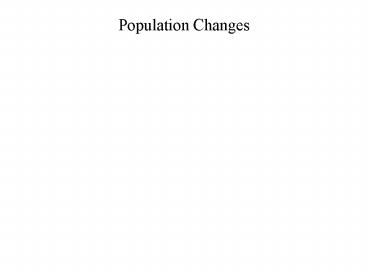Population Changes - PowerPoint PPT Presentation
1 / 17
Title:
Population Changes
Description:
mx = the mean number of offspring produced by females in an age class ... A shift from. exponential. growth to. logistic growth. Exponential growth of collared doves ... – PowerPoint PPT presentation
Number of Views:54
Avg rating:3.0/5.0
Title: Population Changes
1
Population Changes
2
- Life history table
- x an age class
- lx proportion of the initial sample that has
survived to a certain age . - a Fecundity table
- mx the mean number of offspring produced by
females in an age class - lmx proportional number of offspring produced
by an age class - source of information about population dynamics
3
Species with non-overlapping generations
4
- For species with overlapping generations
- Things of ecological importance include
- 1. Net reproductive rate (R0)
- 2. Average generation time (T)
- 3. Per capita rate of increase (r)
5
r lnRo / T -0.509 / 10.6 -0.048
6
T generation time T S xlxmx / Ro
0.940
Task calculate 1. Generation time and 2. State
of population (growth) A. from R0 B. from r r
lnRo / T
0.188
7
Age class structure
L to R 3n parthenogen originating from 2n
parthenogen X 2n biparental
8
Age distributions
9
Population Growth
- Reproductive potential of species guarantees that
habitats can be filled. - Population growth can be simulated by
mathematical models if nature is simplified and
various assumptions are met. - Testing models generally done in a controlled
laboratory setting. - May be little resemblance to natural populations.
10
Some Factors Affecting Model Reliability
- 1. Relationship of population growth to
population density may not be linear. - 2. Effects of density on increase in populations
size may be lagged. - 3. Environmental effects on individuals and
populations are not constant. - 4. Genetic variation means that some individuals
reproduce more than others. - 5. Population size can fluctuate by immigration
and emigration.
11
- 1. Geometric population growth
- Populations with non-overlapping generations
pulsed growth - Generates a J-shaped growth curve
- Found in environments with temporary unlimited
resources, Unoccupied habitats, open niches - Geometric growth ?N
- Need a value for ?, a constant
- ? geometric rate of increase
- ? Nt 1 / Nt
- Starting with a population of 5,000, the
population is 6,000 after one episode of
reproduction - ? ? 6000/5000 1.2
12
Using ? sequentially
13
- 2. Exponential population growth
- Populations with overlapping generations and
continuous growth - Generates a J-shaped growth curve
- Found in environments with temporary, unlimited
resources, Unoccupied habitats, open niches - Exponential growth dN/dt rmaxN
- rmax maximum per capita rate of increase
intrinsic rate of increase - rmax would be estimated under ideal conditions of
unlimited resources
14
Unconstrained Population Growth
- Nt1 Nt Nt(r)
- discrete form
- Nt No(ert)
- continuous form
- With exponential growth across 20 years, what is
your estimate of population size starting with
300,000 individuals and r 0.02? - N20 447,529
15
- Most modeling will only occasionally approach
natural conditions. - However, patterns can be observed in nature that
fit particular growth models.
16
Exponential growth of Scots pine
17
Exponential growth of collared doves
A shift from exponential growth to logistic growth































